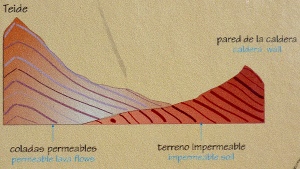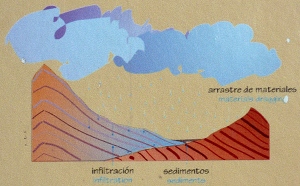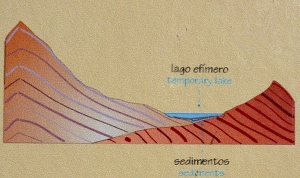Llano de Ucanca EarthCache
-
Difficulty:
-

-
Terrain:
-

Size:  (not chosen)
(not chosen)
Please note Use of geocaching.com services is subject to the terms and conditions
in our disclaimer.
Teide National Park
Introduction
Teide National Park (El Parque Nacional del Teide) is a World
Heritage site located in the Canary Islands of Spain from 28° 09'
00" to 28° 20' 00"N by 16°29' 00" to16°44' 00"W. Teide on the
island of Tenerife is the highest mountain in Spain and at 7,500
meters (m) above the sea floor, is the world's third largest
volcanic structure. It is a shield volcano that combines a severely
beautiful landscape, often wreathed in cloud, with a great variety
of volcanic features with uncommon altitude-adapted endemic flora
and invertebrate fauna. It has been long studied. The high
unpolluted location makes it a natural laboratory for astrophysical
research, for monitoring climatic change and global atmospheric
pollution in addition to the study of the geological processes
which created it.
Altitude
1,650 m-3,718 m (Teide, 3,134 m Pico Viejo).
Physical Features
Teide is the highest mountain in Spain, an impressive stratovolcano
in the center of the island of Tenerife, the largest of the Canary
Islands, a chain formed like the Hawaiian Islands by the passing of
the under-lying lithospheric plate across a magma plume. The
nominated core and associated protected areas cover over a third of
the island. Its peaks of Teide and Pico Viejo rise 1,700 m and
1,340 m respectively from the encircling 16 km-wide caldera of the
huge ancient Las Canadas volcano, which erupted violently 200,000
years ago. The present volcano which is the third highest in the
world after Mauna Loa and Mauna Kea, rises 7,500 m from the ocean
floor and was created over a long period by a low-intensity
magmatic hot spot beneath an almost stationary tectonic plate. It
is of great scientific interest because it concentrates in a
palimpsest of successive eruptive and effusive landscapes a wide
range of geological and magmatic features characteristic of such
mid-plate oceanic islands. Most notable is the vast caldera of Las
Canadas (the springs) created by a landslide, floored at the 2,000
m level by lava fields, walled by a 600 m escarpment of
multicolored rocks, overlaid on the north side by the high volcanic
summits rising out of it. The crescent-shaped floor of the caldera
teems with a network of smaller volcanic mouths, cones, domes, lava
channels, dikes, lavas from light felsic flows to viscid red lavas
and black obsidian blocks, ochre plains of sandy alluvial deposits
and red and black volcanic ejecta, scoria, lapilli and pumice, from
a long series of basaltic effusions. They form the most varied
collection known of volcanic structures, forms and detritus. The
rocky soil is droughty but nutrient- and mineral-rich, and of many
colors, in one place, Los Azulejos, greenish in cast. Under the
intense sunlight the harsh red-brown desertic coloring streaked
with basalt and, in season, bright with flowers, are very
striking.
Visitors and Visitor
Facilities
In the last decades of the 19th Century Teide became one of the
first nature geo-tourism centers with the construction of the
Altavista Refuge at 3,270m specifically for ecotourism (now
reconstructed, with 60 beds). Now, there are about 3.5 million
tourists a year, making it one of the most visited volcanoes in the
world. Visitors are channeled through two educational programs: a
Regulated Education program for scientists and a Public Use program
served by a network of facilities and equipment, with guided tours
for the public, educational lectures and school tours, training
tours and environmental workshops. There are visitors' centers at
the Parador de Las Cañadas del Teide hotel (Cañada Blanca) and at
El Portillo which has a botanic garden of endemic plants and a fire
and first aid station. There are also mountain refuges, several
restaurants, a cable car with stations at 2,350 m and 3,550 m and a
communications relay station. In addition to hiking, there are
camping, climbing, caving and bike tours. The Park Service runs the
educational Muñoz Nature Activities center just outside the
Park.
This is an extract from the information on "The
Encyclopedia of Earth" Website. For further reading please see the
full article here.
Llano de Ucanca
A "cañada" is a
sedimentary plain which is light yellow in colour and is normally
found at the foot of the walls of the cirque where all the material
resulting from erosion of the escarpments accumulates.
Some like that of Ucanca, which also gets sediment from the Teide,
can be as large as 3 km in diameter. In winter it is not unusual to
see small lakes that form in the cañada only to disappear again
later.
| How a Temporary Lake is
Formed |
 |
While the wall of the caldera is made up of impermeable
materials, it's interior is extremely permeable |
 |
When it rains, the water trickles down the wall carrying with
it materials of all sizes, which are deposited at it's base; the
ticker is laid down first, while the finer material is deposited
further away. |
 |
In areas covered with deposits of fine sediments, water slowly
filters through, but during spells of heavy rain, lakes are formed,
lasting for just a few ... |
Logging
Requirements
Before logging, take a look at the info board in the posted
coordinates and send us an e-mail with the answers to the following
questions:
- How long does a temporary
lake lasts?
- What is the most common
bird of prey in this area?
The above information was compiled from the following
sources:
- United Nations Environment
Programme-World Conservation Monitoring Centre (Content Partner);
Mark McGinley (Topic Editor);. 2008. "Teide National Park, Spain."
In: Encyclopedia of Earth. Eds. Cutler J. Cleveland (Washington,
D.C.: Environmental Information Coalition, National Council for
Science and the Environment). [First published in the Encyclopedia
of Earth April 18, 2008; Last revised July 9,2008] <http://www.eoearth.org/article/Teide_National_Park,_Spain>
- Canarias.com Canary Isles:
Teide Mountain <http://en.canarias.com/search/theme.aspx?id=15>
- Infoboards at Teide
National Park.
Additional Hints
(No hints available.)